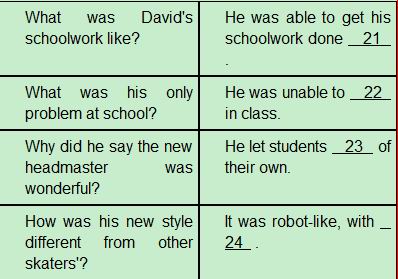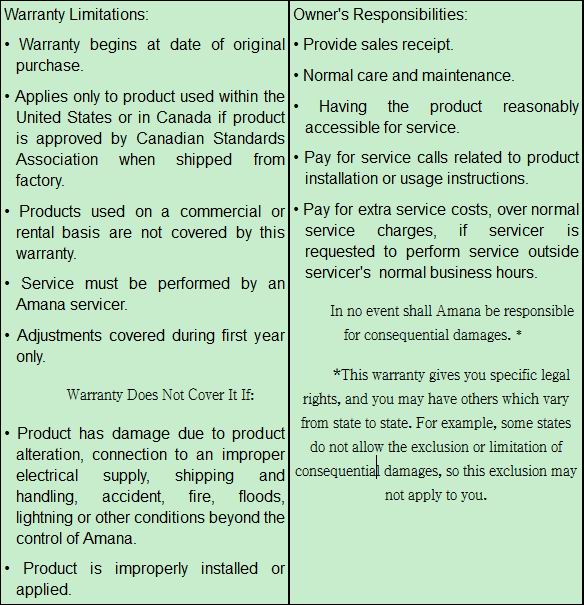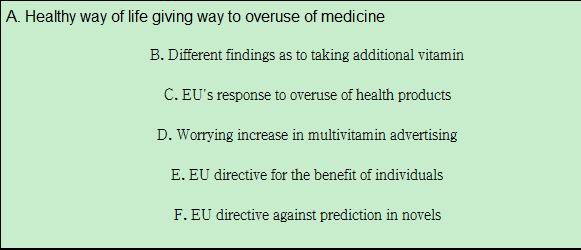




Directions: In Section A, you will hear ten short conversations between two speakers. At the end of each conversation, a question will be asked about what was said. The conversation and the question will be spoken only once. After you hear a conversation and the question about it, read the four possible answers on your paper, and decide which one is the best answer to the question you have heard.
1. A. A basketball player.
B. A laundry worker.
C. A window washer.
D. A rock climber.
2. A. She is not hungry.
B. She wants to cook.
C. She is not tired.
D. She wants to dine out.
3. A. Promising.
B. Isolated.
C. Crowded.
D. Modern.
4. A. To a stationery shop.
B. To a gymnasium.
C. To a paint store.
D. To a news stand.
5. A. The man can see a different view.
B. The food is not tasty enough.
C. The man cannot afford the food.
D. The food is worth the price.
6. A. She reads different kinds of books.
B. She also finds the book difficult to read.
C. She is impressed by the characters.
D. She knows well how to remember names.
7. A. The man will go to the post office.
B. The post office is closed for the day.
C. The woman is expecting the newspaper.
D. The delivery boy has been dismissed.
8. A. She is not sure if she can join them.
B. She will skip the class to see the film.
C. She will ask the professor for leave.
D. She does not want to see the film.
9. A. Fashion designing is a booming business.
B. School learning is a must for fashion designers.
C. He hopes to attend a good fashion school.
D. The woman should become a fashion designer.
10. A. Few people drive within the speed limit.
B. Drivers usually obey traffic rules.
C. The speed limit is really reasonable.
D. The police stop most drivers for speeding.
Directions: In Section B, you will hear two short passages, and you will be asked three questions on each of the passages. The passages will be read twice, but the questions will be spoken only once. When you hear a question, read the four possible answers on your paper and decide which one would be the best answer to the question you have heard.
Questions 11 through 13 are based on the following passage.
11. A. A book publisher.
B. A company manager.
C. A magazine editor.
D. A school principal.
12. A. Some training experience.
B. A happy family.
C. Russian assistants' help.
D. A good memory.
13. A. Lynn's devotion to the family.
B. Lynn's busy and successful life.
C. Lynn's great performance at work.
D. Lynn's efficiency in conducting programs.
Questions 14 through 16 are based on the following passage.
14. A. Economic questions.
B. Routine questions.
C. Academic questions.
D. Challenging questions.
15. A. Work experience.
B. Educational qualifications.
C. Problem-solving abilities.
D. Information-gathering abilities.
16. A. Features of different types of interview.
B. Skills in asking interview questions.
C. Changes in three interview models.
D. Suggestions for different job interviews.
Directions: In Section C, you will hear two longer conversations. The conversations will be read twice. After you hear each conversation, you are required to fill in the numbered blanks with the information you have heard. Write your answers on your answer sheet.
Blanks 17 through 20 are based on the following conversation.
Complete the form. WriteONE WORD for each answer.

Blanks 21 through 24 are based on the following conversation.
Complete the form. WriteNO MORE THAN THREE WORDS for each answer.

Directions: Beneath each of the following sentences there are four choices marked A, B, C and D. Choose the one answer that best completes the sentence.
25. —I'm looking for a nearby place for my holiday. Any good ideas?
—How about the Moon Lake? It is easy reach of the city.
A. by
B. beyond
C. within
D. from
26. Those who smoke heavily should remind of health, the bad smell and the feelings of other people.
A. theirs
B. them
C. themselves
D. oneself
27. Bob called to tell his mother that he couldn't enter the house, for he his key at school.
A. had left
B. would leave
C. was leaving
D. has left
28. It's a clock, made of brass and dating from the nineteenth century.
A. charming French small
B. French small charming
C. small French charming
D. charming small French
29. The school board is made up of parents who to make decisions about school affairs.
A. had been elected
B. had elected
C. have been elected
D. have elected
30. They promised to develop a software package by the end of this year, they might have.
A. however difficult
B. how difficult
C. whatever difficulty
D. what difficulty
31. The judges gave no hint of what they thought, so I left the room really .
A. to be worried
B. to worry
C. having worried
D. worried
32. The students are looking forward to having an opportunity society for real-life experience.
A. explore
B. to explore
C. exploring
D. explored
33. I have no idea the cell phone isn't working, so could you fix it for me?
A. what
B. why
C. if
D. which
34. Young people may risk deaf if they are exposed to very loud music every day.
A. to go
B. to have gone
C. going
D. having gone
35. Sophia got an e-mail her credit card account number.
A. asking for
B. ask for
C. asked for
D. having asked for
36. I cannot hear the professor clearly as there is too much noise I am sitting.
A. before
B. until
C. unless
D. where
37. at the photos, illustrations, title and headings and you can guess what the reading is about.
A. To look
B. Looking
C. Having looked
D. Look
38. An ecosystem consists of the living and nonliving things in an area interact with one another.
A. that
B. where
C. who
D. what
39. Among the crises that face humans the lack of natural resources.
A. is
B. are
C. is there
D. are there
40. Some people care much about their appearance and always ask if they look fine in they are wearing.
A. that
B. what
C. how
D. which
Directions: Complete the following passage by using the words in the box. Each word can only be used once. Note that there is one word more than you need.

Directions: Read the following three passages. Each passage is followed by several questions or unfinished statements. For each of them there are four choices marked A, B, C and D. Choose the one that fits best according to the information given in the passage you have just read.
For some people, music is no fun at all. About four percent of the population is what scientists call "amusic." People who are amusic are born without the ability to recognize or reproduce musical notes (音调). Amusic people often cannot tell the difference between two songs. Amusics can only hear the difference between two notes if they are very far apart on the musical scale.
As a result, songs sound like noise to an amusic. Many amusics compare the sound of music to pieces of metal hitting each other. Life can be hard for amusics. Their inability to enjoy music sets them apart from others. It can be difficult for other people to identify with their condition. In fact, most people cannot begin to grasp what it feels like to be amusic. Just going to a restaurant or a shopping mall can be uncomfortable or even painful. That is why many amusics intentionally stay away from places where there is music. However, this can result in withdrawal and social isolation. "I used to hate parties," says Margaret, a seventy-year-old woman who only recently discovered that she was amusic. By studying people like Margaret, scientists are finally learning how to identify this unusual condition.
Scientists say that the brains of amusics are different from the brains of people who can appreciate music. The difference is complex, and it doesn't involve defective hearing. Amusics can understand other nonmusical sounds well. They also have no problems understanding ordinary speech. Scientists compare amusics to people who just can't see certain colors.
Many amusics are happy when their condition is finally diagnosed (诊断). For years, Margaret felt embarrassed about her problem with music. Now she knows that she is not alone. There is a name for her condition. That makes it easier for her to explain. "When people invite me to a concert, I just say, 'No thanks, I'm amusic,'" says Margaret. "I just wish I had learned to say that when I was seventeen and not seventy."
65. Which of the following is true of amusics?
A. Listening to music is far from enjoyable for them.
B. They love places where they are likely to hear music.
C. They can easily tell two different songs apart.
D. Their situation is well understood by musicians.
66. According to paragraph 3, a person with "defective hearing" is probably one who .
A. dislikes listening to speeches
B. can hear anything nonmusical
C. has a hearing problem
D. lacks a complex hearing system
67. In the last paragraph, Margaret expressed her wish that .
A. her problem with music had been diagnosed earlier
B. she were seventeen years old rather than seventy
C. her problem could be easily explained
D. she were able to meet other amusics
68. What is the passage mainly concerned with?
A. Amusics' strange behaviours.
B. Some people's inability to enjoy music.
C. Musical talent and brain structure.
D. Identification and treatment of amusics.


69. According to Warranty Limitations, a product can be under warranty if .
A. shipped from a Canadian factory
B. rented for home use
C. repaired by the user himself
D. used in the U.S.A.
70. According to Owner's Responsibilities, an owner has to pay for .
A. the loss of the sales receipt
B. a servicer's overtime work
C. the product installation
D. a mechanic's transportation
71. Which of the following is true according to the warranty?
A. Consequential damages are excluded across America.
B. A product damaged in a natural disaster is covered by the warranty.
C. A faulty cabinet due to rust can be replaced free in the second year.
D. Free repair is available for a product used improperly in the first year.
A team of engineers at Harvard University has been inspired by Nature to create the first robotic fly. The mechanical fly has become a platform for a series of new high-tech systems. Designed to do what a fly does naturally, the tiny machine is the size of a fat housefly. Its mini wings allow it to stay in the air and perform controlled flight tasks.
"It's extremely important for us to think about this as a whole system and not just the sum of a bunch of individual components (元件)," said Robert Wood, the Harvard engineering professor who has been working on the robotic fly project for over a decade. A few years ago, his team got the go-ahead to start piecing together the components. "The added difficulty with a project like this is that actually none of those components are off the shelf and so we have to develop them all on our own," he said.
They engineered a series of systems to start and drive the robotic fly. "The seemingly simple system which just moves the wings has a number of interdependencies on the individual components, each of which individually has to perform well, but then has to be matched well to everything it's connected to," said Wood. The flight device was built into a set of power, computation, sensing and control systems. Wood says the success of the project proves that the flying robot with these tiny components can be built and manufactured.
While this first robotic flyer is linked to a small, off-board power source, the goal is eventually to equip it with a built-in power source, so that it might someday perform data-gathering work at rescue sites, in farmers' fields or on the battlefield. "Basically it should be able to take off, land and fly around," he said.
Wood says the design offers a new way to study flight mechanics and control at insect-scale. Yet, the power, sensing and computation technologies on board could have much broader applications. "You can start thinking about using them to answer open scientific questions, you know, to study biology in ways that would be difficult with the animals, but using these robots instead," he said. "So there are a lot of technologies and open interesting scientific questions that are really what drives us on a day-to-day basis."
72. The difficulty the team of engineers met with while making the robotic fly was that .
A. they had no model in their mind
B. they did not have sufficient time
C. they had no ready-made components
D. they could not assemble the components
73. It can be inferred from paragraphs 3 and 4 that the robotic fly .
A. consists of a flight device and a control system
B. can just fly in limited areas at the present time
C. can collect information from many sources
D. has been put into wide application
74. Which of the following can be learned from the passage?
A. The robotic flyer is designed to learn about insects.
B. Animals are not allowed in biological experiments.
C. There used to be few ways to study how insects fly.
D. Wood's design can replace animals in some experiments.
75. Which of the following might be the best title of the passage?
A. Father of Robotic Fly
B. Inspiration from Engineering Science
C. Robotic Fly Imitates Real Life Insect
D. Harvard Breaks Through in Insect Study
Section C
Directions: Read the following text and choose the most suitable heading from A-F for each paragraph. There is one extra heading which you do not need.

76. _____________________________
The use of health supplements such as multivitamin tablets has increased greatly in the western world. People take these supplements because advertising suggests that they prevent a range of medical conditions from developing. However, there is concern that people are consuming worryingly high doses of these supplements and the European Union (EU) has issued a directive that will ban the sale of a wide range of them. This EU directive should be supported.
77. _____________________________
Research suggests that people who take Vitamin C supplements of over 5000 milligrams a day are more likely to develop cancer. This shows how much damage these health supplements do to people's health. A spokesman for the health supplement industry has argued that other research shows that Vitamin C supplements help prevent heart disease, but we can dismiss this evidence as it is from a biased source.
78. _____________________________
Science fiction of the 1960s and 1970s predicted that pills would replace meals as the way in which people would get the fuel they needed. This, it was argued, would mean a more efficient use of time as people wouldn't have to waste it preparing or eating meals. The EU directive would help prevent this nightmare of pills replacing food becoming a reality.
79. _____________________________
People already take too many pills instead of adopting a healthier lifestyle. For example, the consumption of painkillers in Britain in 1998 was 21 tablets per year for every man, woman and child in the country. People do not need all these pills.
80. _____________________________
Some might argue that the EU directive denies people's right to freedom of choice. However, there are many legal examples for such intervention when it is in the individual's best interests. We now make people wear seatbelts rather than allowing them to choose to do so. Opposing the EU directive would mean beneficial measures like this would be threatened.
Directions: Read the passage carefully. Then answer the questions or complete the statements in the fewest possible words.
A study of more than five million books, both fiction and non-fiction, has found a marked decline in the use of emotional words over time. The researchers from the University of Bristol used Google Ngram Viewer, a facility for finding the frequency of terms in scanned books, to search for more than 600 particular words identified as representing anger, dislike, fear, joy, sadness and surprise.
They found that almost all of the categories (类别) showed a drop in these "mood words" over time. Only in the category of fear was there an increase in usage.
"It is a steady and continuous decrease," said Dr Alberto Acerbi. He assumed that the result might be explained by a change in the position occupied by literature, in a crowded media landscape. "One thing could be that in parallel to books the 20th century saw the start of other media. Maybe these media—movies, radio, drama—had more emotional content than books."
Although both joy and sadness followed the general downwards trend, the research, published in the journal PLOS One, found that they also exhibited another interesting behaviour:the ratio (比率) between the two varied greatly, apparently mirroring historical events.
During the Roaring Twenties the joy-to-sadness ratio reached a peak that would not occur again until before the recent financial crash. But the ratio plunged at the height of the Second World War. Nevertheless, the researchers held a reserved opinion about their claim that their result reflected wider social trends. In the paper, they even argue that the reverse could be true.
"It has been suggested, for example, that it was the suppression (压抑) of desire in ordinary Elizabethan English life that increased demand for writing 'filled with romance and sex' ... perhaps," they conclude, "songs and books may not reflect the real population any more than catwalk models reflect the average body."
(Note: Answer the questions or complete the statements in NO MORE THAN TEN WORDS.)
81. A study of more than five million books indicated a decline in "mood words" over time except .
82. According to Dr Alberto Acerbi, one reason for the drop of "mood words" in books may be that .
83. What were the two periods when the joy-to-sadness ratio was at its highest?
84. While the researchers found some changes in the use of "mood words" in books, they were not sure that .